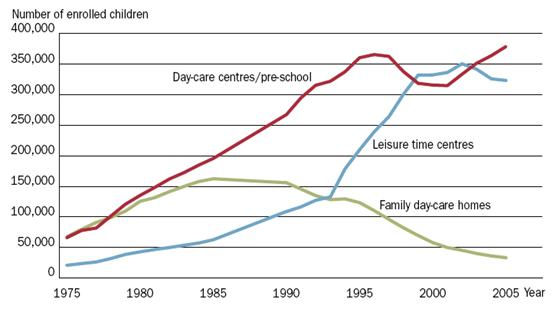With recent childcare reforms, and Labor’s maternity leave program in place, it is worth taking a moment to consider the economic and social effects of such policies.
Enabling access to the workforce for both parents through child care subsidies is admirable goal (for brevity I treat maternity leave as a form of subsidised home childcare). Yet the unintended consequence is to encourage women with young children to work rather than stay home with their children. Social equality for mothers, rather than bringing families together, may be tearing them apart.
We can look abroad to investigate the impact of generously subsidised childcare. In Sweden, a country where twelve months maternity leave is the norm, more than 80% of children under 5 years of age attend formal day care. This figure must be closer to 100% of children aged 1-5, given that mothers (or fathers) are paid to stay home for the first year of their child’s life. In Australia, the number of children under 5 in formal day care is currently less than 40%, and much of that I would imagine is part time.
While the working mother gains all the benefits from subsidised childcare, it is the stay-at-home parent who bears a substantial cost (as well as taxpayers choosing not to have children):
…the popularity of parental leave brought higher taxes and lower benefits for home-caring parents. As more parents were trapped in dual-income lifestyles the burden on taxpayers increased to fund them, particularly threatening single-earner families, who were paying twice over, for their own and others’ parental leave.
Consider this comment (all quotes from here):
Policies such as childcare and parental leave have meant that the majority of Swedish women are employed in the labour market and remain there throughout their lives, with only minor interruptions after the birth of a child.
And:
From 1990-1998 the percentage of women engaged in part-time work fluctuated between 43 and 47 percent, while since then it has decreased to between 33 and 36 percent.
It appears more kids in full time, rather than part time, childcare is what you get.
The following graph is of the period following the introduction of 180 days parental leave, at 90% of previous salary, in 1974 in Sweden. This was extended to 9 months in 1978:

During the 1970s and 1980s, the state and the municipalities both covered approximately 45 per cent of the fees, leaving the remaining 10 per cent to be covered by parental fees.
Again, subsidising childcare works, in that it increases the uptake of childcare. Not subsidising it works too. Cost of childcare exploded in the 1990s, and:
…by 1998, 17 per cent of the costs of childcare were being covered by parental fees
The graph above clearly shows this impact. But what of the early 2000s boom? We have another policy change to explain that one.
In July 2001 the Swedish government expanded childcare to include children of parents who are unemployed and in January 2002 to include children of parents who are on parental leave looking after a sibling (Swedish National Agency for Education, 2003). In addition, in January 2003 all children aged 4-5 became entitled to 525 hours of free attendance in childcare per year.
It is time for the pro-maternity leave lobby to ask whether having almost all of our children aged 1-5 in full time childcare is a desirable social outcome. Like most social and economic policies, there is an inherent tradeoff, and we need a clear social purpose against which this tradeoff can be evaluated.
For example, the pro-childcare subsidy supporters appear to want to provide more equal work opportunities for mothers. Fair enough. But should such a policy favour working parents over stay-at-home parents?
An alternative, much broader, social purpose is to reduce the costs of child rearing. This can also be achieved by granting similar subsidies to parents who choose to stay home with their children rather than put them in day care. The current parenting payment scheme has this effect to some degree, although one can qualify for this payment in addition to child care subsidies.
Or even more broadly perhaps this is a population policy in disguise. In which case there are no reasons to subsidise parents at all, since immigration policy can ensure a stable population.
Childcare and maternity leave policies may be unintentionally promoting a continued outsourcing of parental responsibility. We have the power to create social policies for desirable ends, but a proper, honest evaluation of the tradeoffs is critical.
Tips, suggestions, comments and requests to [email protected] + follow me on Twitter @rumplestatskin